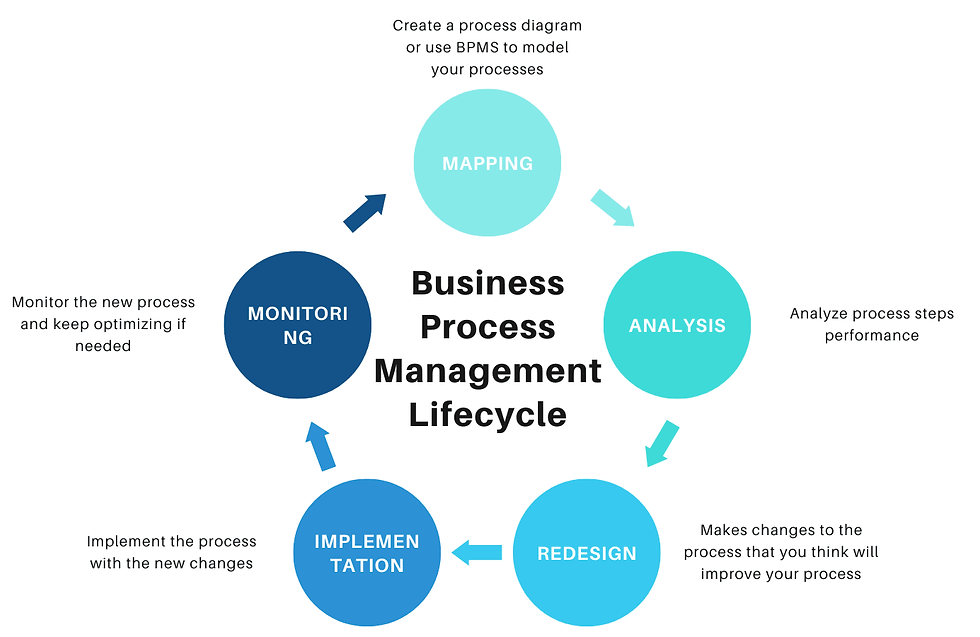How to Identify and Eliminate Bottlenecks in Your Business Processes
- sandyarsenaulttech
- Dec 26, 2024
- 3 min read
In any business, inefficiencies and delays can be major roadblocks to growth and success. These inefficiencies, often referred to as bottlenecks, occur when a part of the process slows down the entire workflow, causing delays, reduced productivity, and frustration. Identifying and eliminating bottlenecks is essential for improving the efficiency of business processes, whether it’s a sales pipeline, manufacturing, or customer service. In this blog, we’ll discuss how to identify and address bottlenecks in your business processes.

What is a Bottleneck in Business Processes?
A bottleneck refers to a point in a process where the flow of work is hindered or slowed down, typically due to limitations in capacity or resources. Bottlenecks reduce the overall speed and efficiency of a process, affecting the quality of output and customer satisfaction. They can appear in any part of a process, from production to communication, and if left unaddressed, they can result in missed deadlines, decreased performance, and loss of revenue.
Step 1: Mapping Your Business Processes
Before identifying bottlenecks, it’s essential to have a clear understanding of your business processes. Process mapping involves documenting each step of the process from start to finish. Whether it's a sales pipeline, manufacturing line, or customer service workflow, mapping helps to visualize the entire flow and highlights potential areas for improvement. Tools like flowcharts, process diagrams, or Kanban boards can be extremely helpful for this purpose.
By reviewing these maps, you can gain valuable insights into where delays are occurring. These could be caused by inefficient processes, lack of resources, or outdated technologies. Understanding the full process will make it easier to spot trouble areas and potential bottlenecks.
Step 2: Collecting Data to Identify Bottlenecks
Once you’ve mapped your processes, the next step is to collect relevant data that can help pinpoint where the bottlenecks are occurring. Performance metrics like throughput, cycle time, or waiting times can reveal which part of the process is lagging. For example, if you notice that the time it takes to complete a specific task is much longer than other stages, that’s likely where the bottleneck is.
Look for key indicators such as:
Delays in approvals or decision-making.
Overburdened resources or tasks that require more time than others.
High error rates or rework that slow down progress.
Step 3: Analyzing the Root Cause of the Bottleneck
Identifying the location of the bottleneck is just the first step. The next critical stage is to determine the root cause. Bottlenecks can stem from various sources, including:
Lack of resources: Insufficient manpower, equipment, or tools can create bottlenecks in a process.
Ineffective communication: Miscommunication or lack of clarity can delay decision-making and lead to inefficiencies.
Outdated technology: Legacy systems can slow down processes and increase the likelihood of errors or delays.
Inadequate training: If employees aren’t properly trained to handle certain tasks, mistakes and delays can occur.
Poor process design: A poorly structured process can naturally lead to delays at specific points.
Once you’ve identified the root cause, you can devise a solution to resolve the bottleneck effectively.
Step 4: Eliminate or Mitigate the Bottleneck
After pinpointing the root cause, it’s time to take action. Solutions will vary depending on the type of bottleneck, but here are some common strategies to eliminate or mitigate them:
Add resources: If a bottleneck is caused by a lack of resources, consider adding more manpower, upgrading equipment, or investing in new technology.
Improve training: Ensure employees have the right skills and knowledge to perform tasks efficiently, reducing delays caused by mistakes or misunderstandings.
Automate processes: Implementing automation tools can help streamline repetitive tasks and improve the speed of workflows.
Reorganize workflows: Adjust the sequence of tasks to ensure that work is distributed more evenly and efficiently.
Improve communication: Establish clear communication channels and decision-making processes to reduce delays caused by miscommunication.
Step 5: Continuously Monitor and Refine
Bottlenecks can reappear, especially as processes evolve or external factors change. Therefore, it’s important to continuously monitor your business processes and refine them regularly. Establish a routine for tracking performance metrics and assessing the flow of work. This proactive approach helps to identify new bottlenecks before they significantly impact your operations.
Conclusion
Eliminating bottlenecks is crucial for improving the efficiency of your business processes. By identifying the problem areas, analyzing the root cause, and implementing effective solutions, you can ensure smoother workflows, increased productivity, and better outcomes for your organization. Keep in mind that process improvement is an ongoing task. Regularly reviewing and refining your processes will help you stay ahead of potential issues, ensuring that your business can continue to grow and succeed in today’s competitive market.
SITES WE SUPPORT
SOCIAL LINKS



Comments